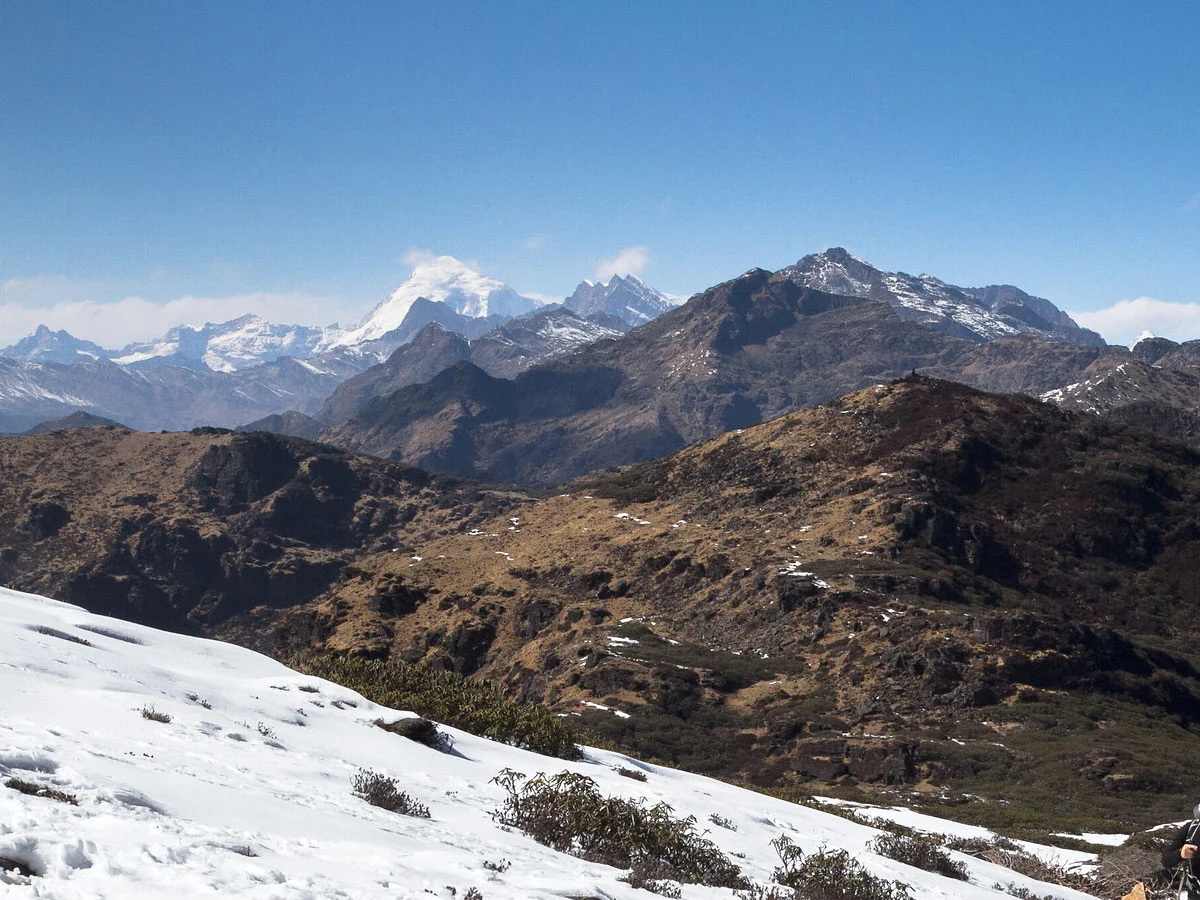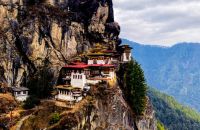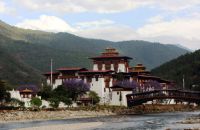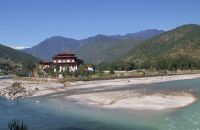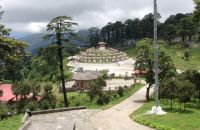Talk with our local travel specialist who can help organize your trip.
How difficult is the Druk Path Trek
Trekking in Bhutan is an experience one should not miss out on if you are visiting the country. Covered by swathes of pristine forests, Bhutan has some of the most awesome trails for trekkers of all fitness levels and experiences. Druk Path Trek is one such trek for people aspiring to experience Bhutan. It's short and easier compared to other treks.
The Druk Path trek is graded as an Easy to Moderate trek. During the trek, the highest point you will reach is Simkotra Tsho (4,110m/13,484ft). The maximum time spent walking on the trail is 5 to 6 hours each day. For beginners, this trek is a doable hike to undertake as the distances between the camps are quite short.
I was about to book a trek to Bhutan in the spring of 2019. It was all peaceful this side of the world and the Covid pandemic had yet to wreak havoc worldwide. I couldn't decide which trek to choose so I thought it better to consult with the tour operator with whom I was about to book my trip.
When asked about which trek would be ideal for me, Sonam (my Bhutanese guide and tour operator) suggested Druk Path Trek. It is short and would be doable, he had replied. Having done the Everest base Camp Trek and the Annapurna Circuit, he opined that the altitude gain won't be a problem for me.
According to him the main difficulty faced by the trekkers on the Druk Path trail was the high altitude. But since I had some experience with high-altitude trekking, the Druk Path Trek would be a piece of cake, as per Sonam. This positive affirmation buoyed me and I was ready to hit the Druk Path trail.
How difficult is the Druk Path Trek? Was it easy for me like Sonam said or was it difficult? Do read on to find out.
The Druk Path Trek, What to expect?

The foot trail of Druk Path Trek connects two major Bhutanese cities Paro and Thimphu. Before roads were built and vehicles were introduced in Bhutan, people used this path to travel between these two cities. This was also one of the chief routes that led to Tibet and many traders and pilgrims walked this route.
The trail weaves across lush alpine forests and serene lakes. There are lots of ascents, descents, ridge walking, and crossings over mountain passes (depending on the route you choose) en route.
Each day our group covered a small distance walking four to five hours. Those with a strong pair of legs were able to reach the campsite within three hours. The short walking time gave us ample time to enjoy our surroundings and savor the views.
Each day after reaching the campsite, we would sit out and watch the sunset over the Himalayan mountains. We were lucky enough to have good weather during the entire trek.
Trekking in Bhutan offers an authentic camping-style trekking experience. It is very different from the tea-house treks of Nepal. Unlike the popular trekking trails in Nepal, the Druk Path trail runs through an uninhabited and wild area. Except for a couple of seasonal shelters of yak herders, there are no lodges or houses en route.
The camping equipment and rations were hauled up to the camping sites by ponies and horses. The camps were set up by the local crew before we reached the camp. We had a large dining tent where we congregated for meals. The kitchen crew served us nutritious meals each day. The items included rice, chappati (flat bread), vegetable stews, soups, pickles, muesli, porridge, etc. Breakfast, evening tea, and dinner were served at the campsite, while lunch was taken en route. The cook would prepare and pack the lunch before setting off each day. The guide chose a quiet and beautiful spot where we enjoyed our picnic lunch.
I slept in a single tent. Although the nights were cold, my sleeping bag was cozy enough to ward off the chill. Hot bottles were offered by the cook to warm our beds before we retired.
From the start of the trek, we were greeted with amazing views of Mount Jomolhari and Jichu Drake, some of the highest Bhutanese mountains. By the end of the trek, we were awed by the splendor of Bhutan's Himalayan peaks including the tallest mountain in the kingdom, Gangkhar Puensum.
Featured Trips
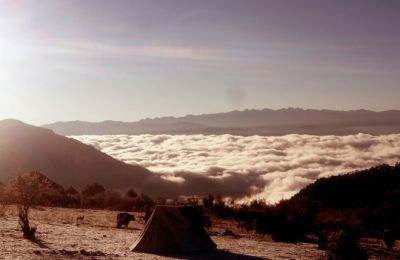
Druk Path Trek - 8 days
Druk Path Trek one of the best short treks in Bhutan, This 8 days itinerary ensures a glimpse of the remarkable landmarks in Bhutan
Inquire Now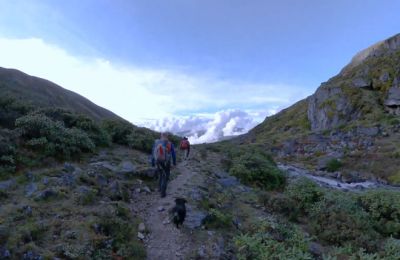
Dagala Thousand Lakes Trek - 8 days
Dagala Thousand Lakes Trek offers an elusive adventure in Bhutan's uninterrupted landscape with vistas of high mountain lakes and the Himalayas.
Inquire NowWhere to travel next?
Get help from our travel specialists for holiday ideas that matches your interests.
Druk Path Trek Itinerary

Although my itinerary was of eight days, the trek lasted for only five days. Depending on your fitness level, the places you want to explore, and the duration of your holiday, you can choose either a longer itinerary of 10 or 12 days or a short holiday of 6 to 8 days. People who are fit and trek regularly at high altitudes can complete this trek in 3 days too.
Before you embark on your trek it is advisable to take an acclimatization hike. I did the Tiger's Nest or Taktsang Monastery Hike in Paro to acclimatize. The five-hour-long hike was grueling and took me to an altitude above 3000 meters.
Apart from preparing myself physically, I was able to visit one of the best-preserved cultural heritage sites in Bhutan. Taktsang Monastery, an ancient building that hangs precariously on the side of a cliff, is a man-made marvel. I believe divine powers were at play when this monastery was built. Being one of Bhutan's sacred Buddhist pilgrimage sites there were many pilgrims on the trail.
The starting point of the Druk Path Trek lies right above Ta Dzong or the National Museum in Paro. There's a dirt trail running above the highway which goes past apple orchards and a few farms. The vehicle dropped us off where the foot trail begin.
The first day's trek brought us to Jele Dzong, an ancient fortress sitting on a grassy ridge. We set up camp below this old watchtower. It was a leisurely walk past a wooded trail filled with rhododendron, fir, and hemlock trees. The rhododendron shrubs were just about to bloom and it was beautiful.
On the second day, our destination was Jangchulaka, a campsite used by yak herders. Walking past Jele Dzong we were able to enjoy panoramic views of Paro and Jomolhari from the ridge.
Our Third day's stop was the shimmering lake of Jimilangtsho. The route to Jimilangtsho took us above the tree line and we could see the majestic Dagala Range rearing in the distance. We crossed the Jangchu La pass and walked on an exposed ride which offered yet another awe-inspiring view of Jomolhari. The camp was set up on the banks of Jimilangtsho, a serene lake that is home to giant trouts. The locals regard this lake as a sacred site therefore no fishing is allowed.
On the fourth day, our target was to reach Simikotra Tsho. We were slowly gaining elevation and some members of our group were feeling the adverse effects of high altitude – headache, giddiness, and nausea. Thankfully popping Diamox, the wonder pill for high-altitude trekking fixed it and no one had to turn back. We encountered a herd of yaks as we gingerly made our way to our campsite at Simikotra Tsho, a place preferred by yak herders too to set up their seasonal camp.
The fifth and the last day's trek was the most difficult. We crossed many high mountain passes including the highest one of the entire trek, Phume La(4210m). The views were breathtaking. We could see the entire mountains of the Himalayan Range in Bhutan. Gangkhar Puensum, the highest mountain in Bhutan, glistened impressively in the distance. As we walked down we stopped briefly at Phajoding Monastery. Later we walked down to the Motithang Takin Reserve where our trek ended. A vehicle was waiting for us on the highway to drive us to Thimphu.
Which is the best season for Druk Path Trek?
Barring the monsoon months (May to September) and mid-winter (end of December, January, and February), Druk Path Trek can be done anytime of the year. The popular trekking seasons are spring and autumn when one can look forward to favorable weather conditions- warm days and clear skies. But as Bhutan is known as the 'Land of the Thunder Dragon' one can expect storms and clouds even in spring and autumn, the two peak seasons for tourism.
Irrespective of the season, while packing and packing list for your trip try to include items that will save you from inclement weather – waterproof gear, waterproof hiking boots with good traction (which will help you get a good grip when the trail gets slippery and muddy), crampons (if you are planning a winter trek) and enough warm layers.
Where to travel next?
Get help from our travel specialists for holiday ideas that matches your interests.
Altitude Gain
From an elevation of 2,280 meters, you will be walking to a height of 4,210 meters. The distances covered each day are short which makes this trek easier physically. You get ample time to rest and recover your strength before heading off the next day.
But those who are not used to high-altitude trekking might still struggle with the elevation gain. Not missing out on the acclimatization hike, taking it slow and easy, and keeping oneself hydrated might help a lot.
How long is the Druk Path Trek?

The Druk Path trek which is graded moderate on the difficulty scale, covers a distance of around 54 kilometers. The route meanders across thick forests of blue pine, rhododendron, cedar and fir, alpine pastures, and mountain lakes. The trail snakes through several mountain passes and ridges en route.
Why you should choose the Druk Path Trek?
For those of you who are trekking in Bhutan for the very first time, there wouldn't be a better walking trail than the Druk Path trail. The Druk Path Trek gently introduces you to Bhutan's gorgeous landscape without overwhelming you with strenuous and physically demanding hikes. You can get a feel of the trail and experience the camping style of trekking before choosing a much more difficult and demanding trek (Snowman Trek or the Laya Gasa Trek).
Most Druk Path trekking itineraries include cultural tours to Paro and Thimphu along with the short trek. You get to experience Bhutan's rich cultural heritage as well as high-altitude trekking by choosing this trek.
As of September 2022, the Bhutanese government has already opened the country to tourists. The country had shut its borders at the end of March 2019, after the Covid-19 pandemic raised an alarm worldwide. With some new rules in place, Bhutan is now welcoming visitors from all over the world. Hailed as one of the top sustainable tourism destinations, a trip to Bhutan is an enriching and unforgettable experience.
A visit to this tiny Himalayan kingdom will not only introduce you to one of the last pristine corners of planet earth, but will show you how a conducive and harmonious existence with nature and environment is possible with the collective effort from the government and the citizens. In this day and age of rapid climate change, Bhutan has a lot to teach us.
I am already planning my next adventure to Bhutan. Aren't you?
- Written by: Naba Raj Amgai
Updated: Sep, 15, 2022

